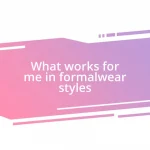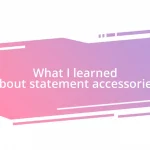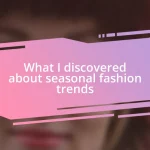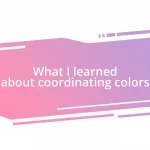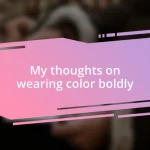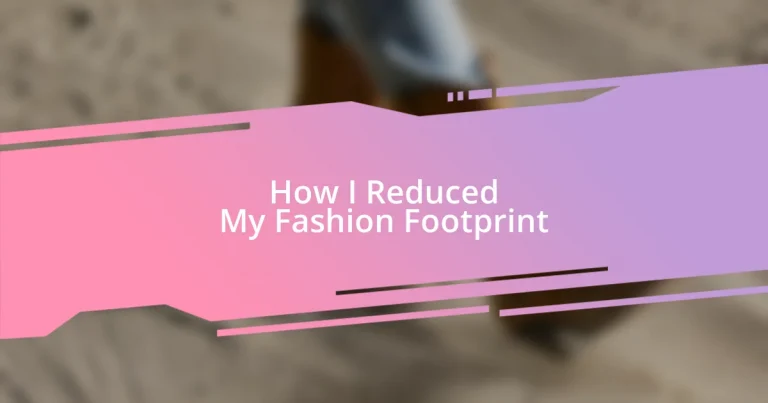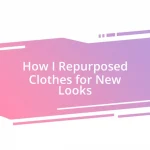Key takeaways:
- The concept of “fashion footprint” emphasizes the environmental and social impact of clothing choices, prompting a shift towards more thoughtful purchasing decisions.
- Embracing sustainable fashion brands and implementing minimalist wardrobe strategies reduces one’s fashion footprint while fostering a deeper connection to clothing.
- Incorporating second-hand shopping, sharing, and recycling fashion items not only supports sustainability but also enriches personal style and creativity.
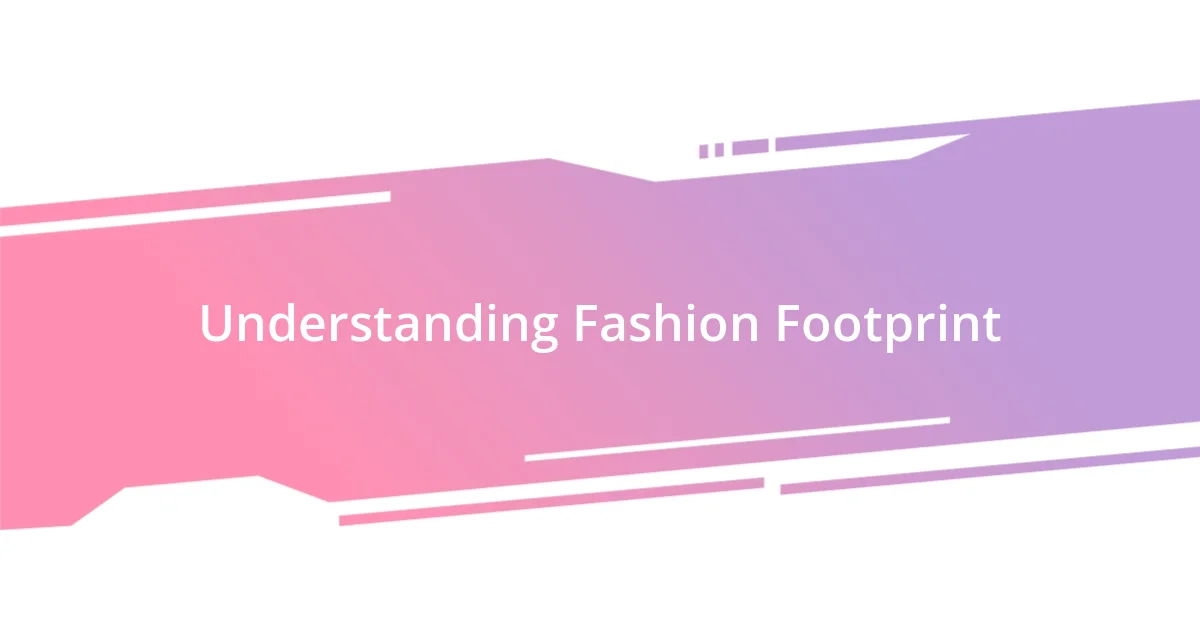
Understanding Fashion Footprint
When I first heard the term “fashion footprint,” I thought it was just a catchy phrase. But it runs much deeper than that. It represents the total environmental and social impact of our clothing choices, from the resources used in production to the conditions of the workers involved. Have you ever wondered just how many hands touch a garment before it reaches your closet?
Each time I looked at a new purchase, I began to think not just about how it would look on me but about the journey it took to get there. The concept of fashion footprint invites us to consider issues like water usage, carbon emissions, and waste. For me, this realization sparked a change. I remember the first time I learned that a single cotton t-shirt can require over 2,700 liters of water. It made me reflect on how I can truly make a difference with my buying decisions.
Additionally, I’ve noticed how my fashion footprint affects not only the planet but also those who work within the industry. I recall reading stories of garment workers, often in perilous conditions, creating the very clothes I wore. This connection shifted my perception entirely, compelling me to seek out brands that prioritize ethical practices and sustainable materials. What impact do your clothing choices have on both people and the planet?
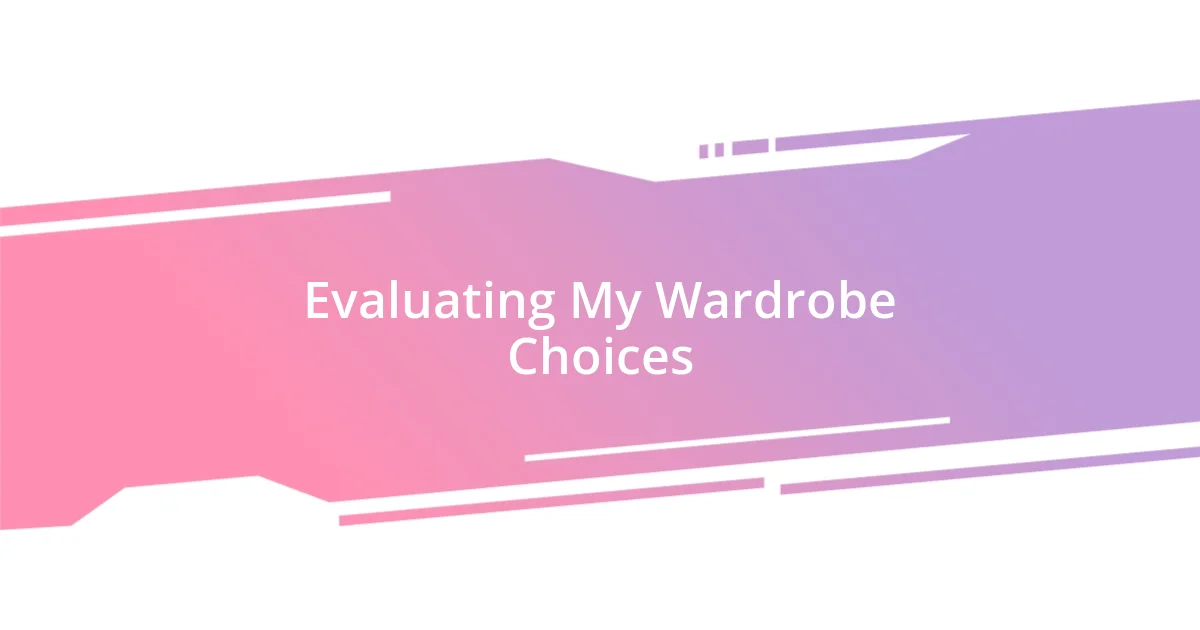
Evaluating My Wardrobe Choices
Evaluating my wardrobe choices became a transformative experience. I started by pulling out everything from my closet and assessing each item. It was a bit overwhelming at first, but I soon realized I had pieces that I hadn’t worn in years. I felt an emotional tug as I recalled the memories attached to those clothes. Did I buy them just because they were trendy or on sale? This question drove me to dig deeper into the purpose behind my purchases.
As I categorized my clothes—essentials, sentimental pieces, and forgotten items—I identified gaps in my wardrobe. I was surprised to find that I leaned heavily on fast fashion for everyday wear. Reflecting on that, I began to understand how much of my choices were driven by convenience rather than thoughtfulness. It dawned on me: these choices, while convenient, contributed to a cycle of waste and a growing closet of unused items.
To truly evaluate my wardrobe, I created a simple table that summarized my findings. This exercise helped clarify how I can pivot my fashion habits towards more sustainable solutions.
| Wardrobe Category | Action Plan |
|---|---|
| Essentials | Invest in quality, sustainable brands. |
| Sentimental Pieces | Keep but limit storage space. |
| Forgotten Items | Donate or upcycle. |
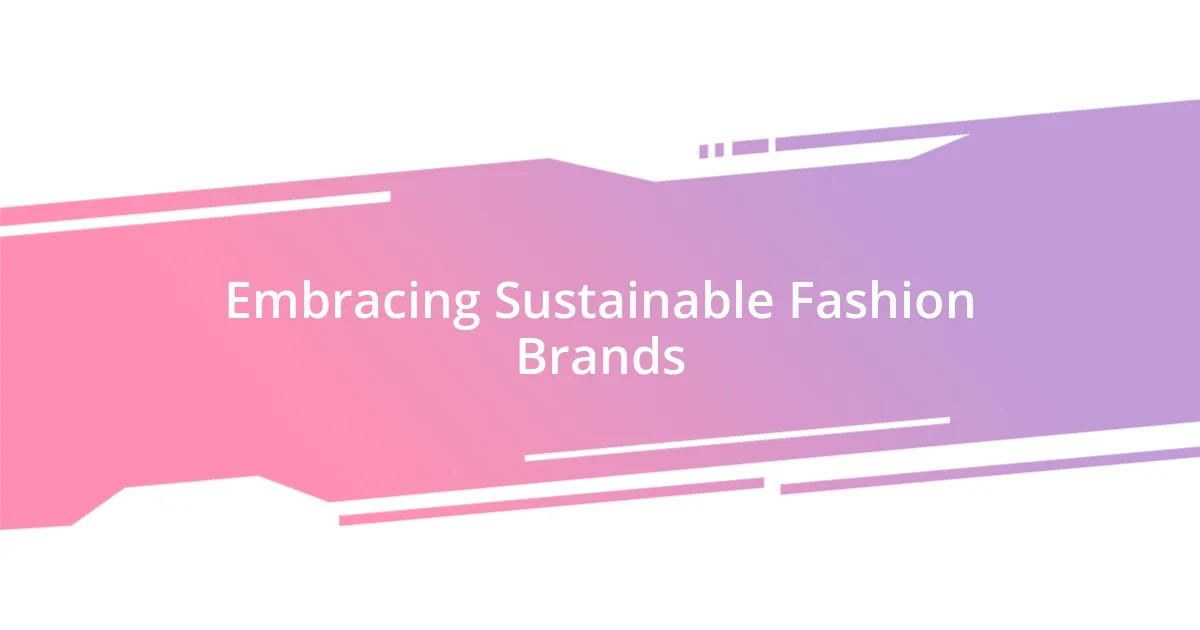
Embracing Sustainable Fashion Brands
Embracing sustainable fashion brands has truly reshaped my shopping habits. I remember the first time I stumbled upon a small, local brand that crafted exquisite pieces from recycled materials. I felt a rush of excitement knowing that my purchase would directly support artisans and reduce waste. The emotional connection to my clothes deepened as I realized I was investing in something that stood for more than just trends.
Here are some sustainable fashion brands that I’ve come to love:
- Patagonia: Known for its commitment to environmental causes and responsible sourcing, this brand has turned me into a loyal customer.
- People Tree: I appreciate their focus on ethical production and fair trade practices.
- Reformation: Stylish yet sustainable, they make it easy to shop for clothes that align with my values.
- Everlane: Their transparent pricing and ethical practices resonated with me, fostering trust in my purchases.
- Eileen Fisher: I admire their dedication to timeless design and sustainable materials, promoting longevity over quick trends.
Integrating these brands into my life has not only reduced my fashion footprint but also filled my wardrobe with pieces I truly love and believe in. Every time I wear something from these labels, I feel a sense of pride knowing I’m making a positive impact.
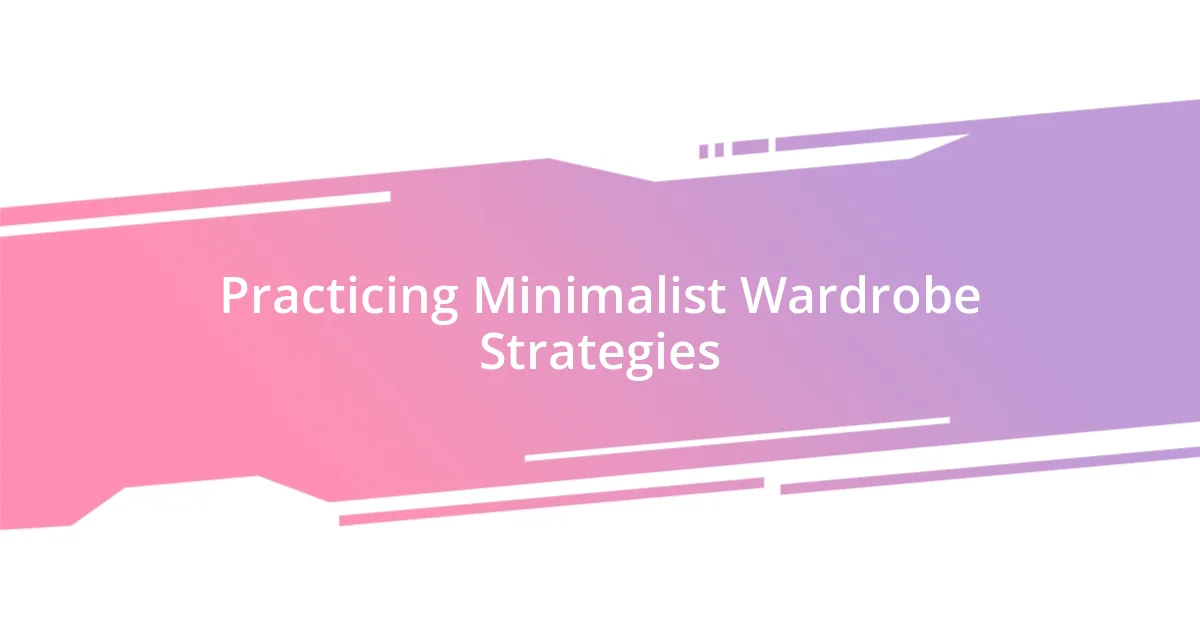
Practicing Minimalist Wardrobe Strategies
Practicing minimalist wardrobe strategies has been a revelation for me. I started with the “capsule wardrobe” approach, which means selecting a limited number of versatile pieces. I remember the first time I created my capsule: I felt liberated standing in front of my closet with just a few quality items that could mix and match seamlessly. You know that feeling when you finally declutter and can see what you truly have? It was a breath of fresh air.
I also learned the importance of investing in timeless pieces, rather than chasing fleeting trends. I went hunting for classic silhouettes and neutral colors, recognizing that these choices really stood the test of time. For instance, I was hesitant at first to invest in a high-quality trench coat, but it has since become a staple that I wear in every season. These kinds of choices not only reduce my spending but also, surprisingly, make getting dressed easier. Who needs the stress of endless options?
One trick that really worked for me was adopting a one-in, one-out policy. Whenever I felt tempted to buy something new, I’d take a hard look at my closet and choose an older item to donate. It’s astounding how quickly that habit shifted my mindset—each new purchase required a critical evaluation, which helped me appreciate what I already owned. Have you ever tried this method? I found it not only curbed my desire to accumulate more but also made me cherish the pieces I truly loved even more.
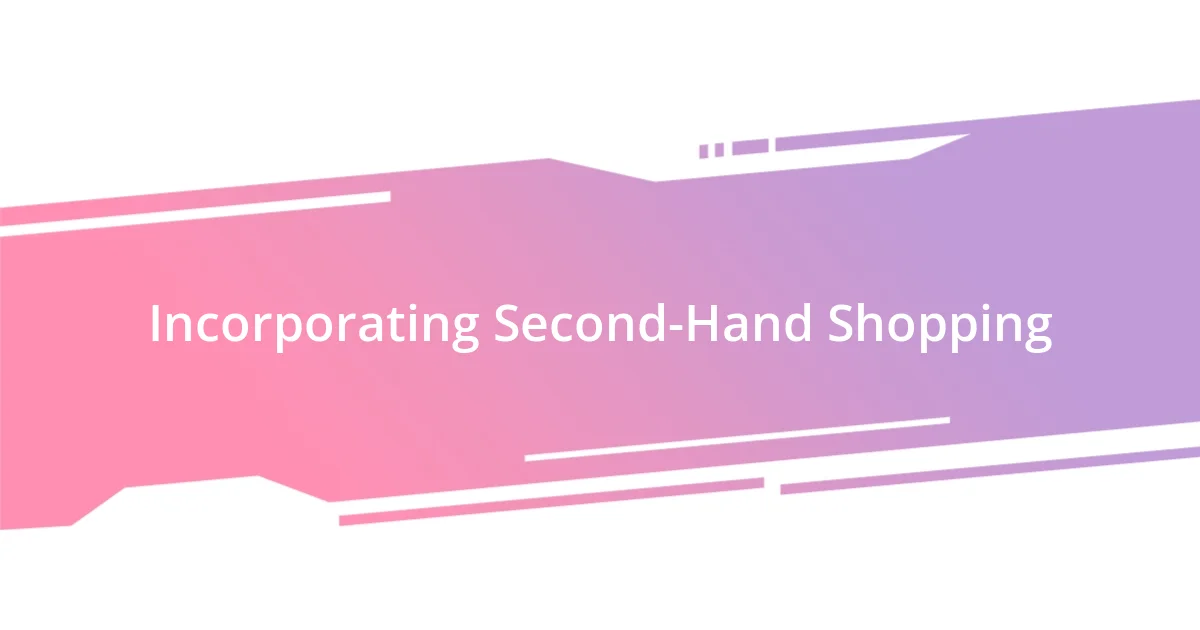
Incorporating Second-Hand Shopping
Incorporating second-hand shopping into my wardrobe has been a delightful and eye-opening journey. I still remember my first visit to a thrift store; the thrill of digging through racks filled with character-rich clothing felt like a treasure hunt. Have you ever stumbled upon an incredible vintage piece? I found a stunning dress that looked like it belonged in a different era, and knowing it had its own story gave it a special charm that new clothing just can’t replicate.
Over time, I’ve honed my skills for second-hand shopping. I’ve learned how to spot quality fabrics and unique designs that truly stand out. I recall finding an authentic leather jacket that seemed to fit as if it was tailored just for me. It was significantly more affordable than anything contemporary, and the satisfaction of rescuing it from being overlooked felt immensely rewarding. Each second-hand item has made me more mindful of how I consume fashion, allowing me to express my style without the environmental cost.
I often encourage friends to join me on thrift-store excursions, as it turns into a fun social event as well. There’s something about sharing that experience—whether bonding over goofy finds or reminiscing about past fashions that makes it memorable. Plus, who doesn’t love the thrill of hunting for someone else’s discarded gems? It’s gratifying to realize that, with every purchase, I’m not just curbing my fashion footprint; I’m participating in a circular economy that’s all about sustainability and creativity.
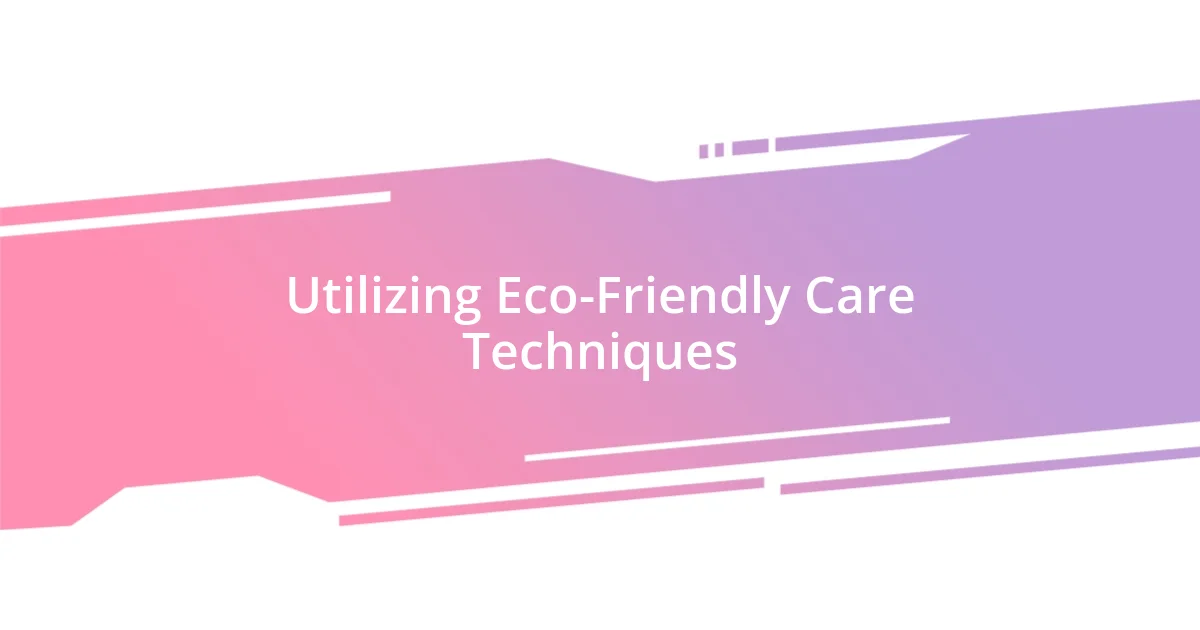
Utilizing Eco-Friendly Care Techniques
Utilizing eco-friendly care techniques has transformed the way I view garment maintenance. I used to toss my clothes in the washing machine without a second thought, but now I’m much more intentional. One simple change that has made a huge difference is washing my clothes in cold water. It not only saves energy but also helps preserve the colors and fibers, allowing my favorite pieces to last longer. Have you ever noticed how vibrant your clothes look when you treat them gently?
Additionally, I’ve embraced air drying my laundry instead of using the dryer. This may seem minor, but it came as a revelation to me. I recall the first time I hung my clothes outside; the fresh air and sunlight added a natural scent and softness that any dryer cycle just can’t replicate. There’s something satisfying about seeing my clothing flapping in the breeze, almost like they’re having their own little vacation. It reduces energy consumption, and I feel a sense of pride knowing I’m doing my part for the planet.
To take it a step further, I’ve become a fan of homemade fabric care solutions. I realized that common store-bought detergents and softeners often contain harsh chemicals. I tried making a simple, eco-friendly detergent using baking soda and vinegar, and it worked wonders! Not only does it clean effectively, but it also gives me peace of mind knowing I’m avoiding unwanted chemicals. It’s rewarding to use something so simple and effective—who knew sustainable choices could feel this empowering?
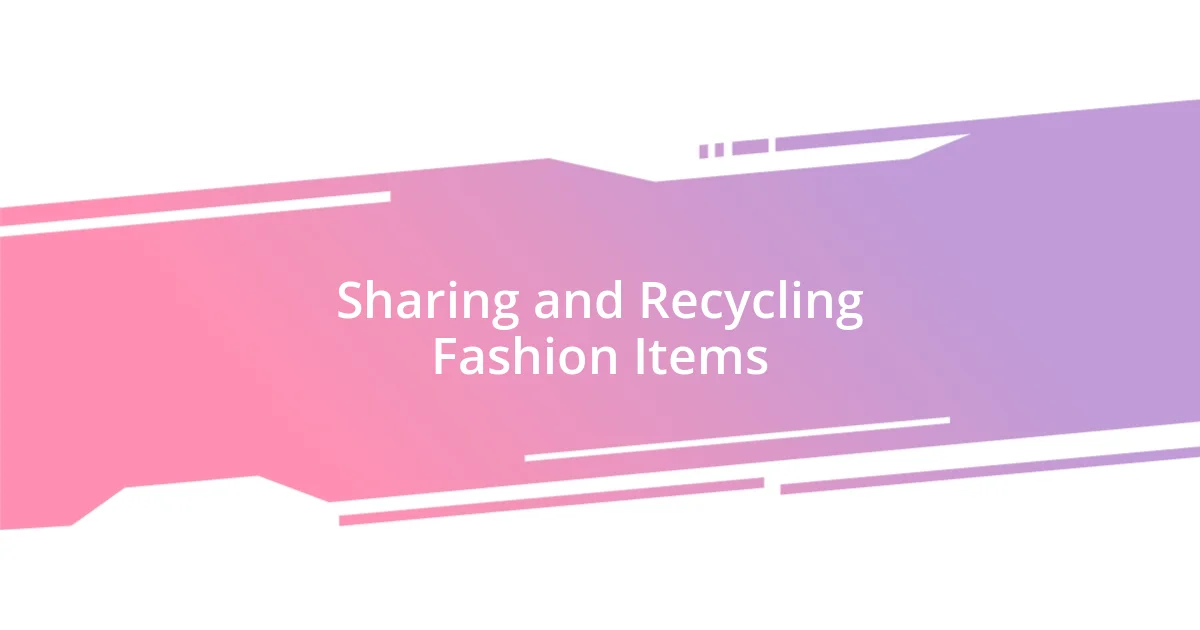
Sharing and Recycling Fashion Items
Sharing and recycling fashion items has genuinely enriched my approach to my wardrobe. I remember the first time I organized a clothing swap with friends. We all brought pieces we no longer wore, and it sparked a fun day filled with laughter, fashion shows, and swapping stories behind each piece of clothing. It was fantastic to see a dress I loved go to a friend who would cherish it just as much. Ever tried a clothing swap? I highly recommend it—it’s a great way to refresh your wardrobe without spending a dime!
Recycling fashion items has also offered me a chance to creatively repurpose clothes I can’t bear to part with. One summer, I transformed an old pair of jeans into a trendy handbag. It released my inner artist and saved me from buying a new bag. I felt a rush of satisfaction knowing I turned something destined for the landfill into a stylish new accessory. Have you considered how many items in your closet could have a second life? Perhaps you’d be surprised by the potential hidden in your own wardrobe.
With apps that facilitate sharing and recycling, the process has never been more accessible. I signed up for a local online marketplace where people buy, sell, or trade clothing. I’ve listed several items I no longer wear, and honestly, seeing someone excited to wear a blouse I loved brought a sense of joy. It’s a charming way to connect with others while extending the life of my clothes, and it’s an effortless step toward sustainability. Isn’t it incredible to think that just one simple act of sharing can echo throughout the ecosystem?


